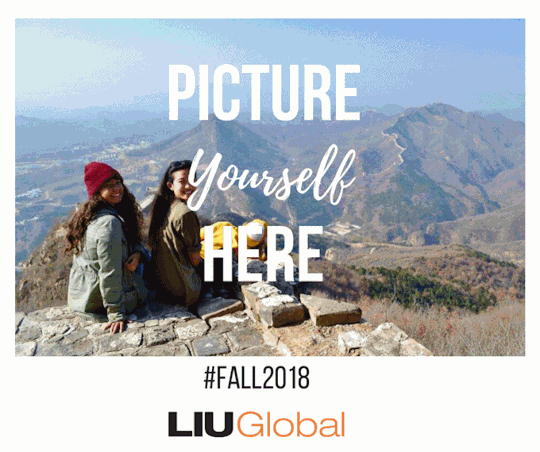Photo

Medium Link
https://medium.com/@liuglobalsocialmedia
5 notes
·
View notes
Photo

My Life As A Pakistani-American Muslim
By: Rina Sarfraz
I’m an 18-year-old female student traveling the world. I happen to be part of a great program called LIU Global where I get to participate in experiential learning while traveling to various countries. But I’m also a Muslim, Pakistani-American, and hijab-wearing female traveling the world. My experience so far has been positive, but it’s not similar to travel blogs posted by white females. My privilege is not equal to a white female or man’s privilege due to the color of my skin and my religious faith. I have been treated very differently in my life compared to my white peers. I have met many people throughout my traveling journey so far that have been very confused as to how I could be from New York. And then starts the story of how I explain where my family and I are originally from.
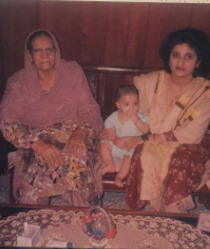
I was born in Pakistan. My parents and I immigrated to the USA when I was 2 years old. We settled in Long Island, New York. I grew up in a predominantly white neighborhood and was fortunate enough to be accepted by most people, even though my family and I faced some racism. After 9/11, my parents struggled to maintain their Muslim faith publicly. My mother was told by people, both Pakistanis and non-Pakistanis, to not observe her faith and to keep a low profile. My mother said she felt very insecure and vulnerable, especially during the time period immediately following 9/11. The USA was not portrayed as the “land of the free” anymore to my parents. The racism that followed my family was intense. And unfortunately, we were not the only Muslims experiencing the negative treatment. There were many stories going around the Muslim community of Muslims being attacked, hijabs forcibly being torn off, and more. One story that hits close to home is when my father was almost shot at his job. Two men yelled racial slurs at him while pointing a gun at him. Luckily, no shots were fired and my father was fine. But this just shows how rapidly and dangerously Islamophobia has spread. My father should not be answering for Islamophobia with his life, let alone any Muslim individual.
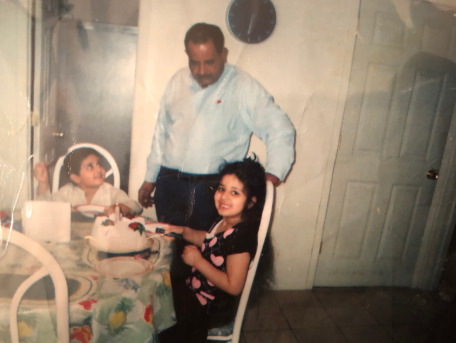
I decided to start wearing the hijab my freshman year of high school. The hijab is a personal choice decided by Muslim women if they would like to wear it. Some Muslim women decide to wear the hijab as a means to fulfill the commitment of modesty, show personal devotion to God, and visibly express their Muslim identity. Once I started wearing the hijab, I experienced both acceptance and rejection. I had some individuals love the idea of how I was expressing myself while others clearly expressed their distaste. Instead of fighting fire with fire, I decided to educate people during high school. I organized my high school’s first Middle Eastern/South Asian Cultural Night twice. I decided to do this event because I saw the importance of acceptance and mutual understanding. I wanted to bridge the divide between different groups of people/ideas. Attendees enjoyed a variety of activities, including coloring mandalas, receiving henna tattoos and eating traditional foods from the Middle Eastern/South Asian regions. I was able to merge people from different upbringings into a night of love, unity, and acceptance. At this event, I revealed my life story to a roomful of friends and strangers, hoping they could relate to my experiences shaped by my culture and religion, yet fearing they’d reject every word I said. But I was not rejected because the event was a success. Many people came both times and it was covered by the local media. Many of the attendees learned a lot and I was glad that I used an opportunity to expand their knowledge.
My family and I came to the USA to obtain the “American Dream”. From the stereotypes to the hate crimes, these realities make Muslim Americans often feel the “American Dream” is simply that: a make-believe, unattainable dream. But we work hard to achieve our potential. Yes, we are immigrants. We are “minorities.” But, we are also part of America’s greatest, brightest future yet. To quote General Jay Silveria of the United States Air Force Academy, “The power of us as a diverse group, the power that we come from all walks of life, from all parts of this country, from all races, all backgrounds, gender, all makeup, all upbringing, the power of that diversity comes together and makes us that much more powerful. That’s a much better idea than small thinking and horrible ideas”. As General Jay Silveria states, leadership does not discriminate. It does not care if you are young or old or rich or poor or man or woman or black or white or brown or yellow or green or pink or any other color that exists. It does not take into account what language you speak or which God you worship. It asks only that you lead. That you lead, be it in an action or in a speech, to enrich the lives of those who follow. So that’s exactly what I continue to do. I stand up for myself and others. I stand up for humanity and the fight against injustice. We need to reject the hatred and confront with love. We need to be leaders in this movement of empowering the rights of all instead of sitting back and watching lives be degraded. It is our utmost responsibility as humans to lead with love and respect. And while I continue to stand up for myself and others, I have always been and will continue to be proud of my identity.
During my time at LIU Global so far, I have experienced curiosity and happiness from my peers, my host family, and other locals. My host mom and local Ticos were curious to know about my religious and cultural background. I gladly told them and was happy to engage in a conversation with them. It’s been interesting living in Costa Rica for the past three months while experiencing traveling in various perspectives. I learned about the small Muslim population in Costa Rica and learned about what religion means to some Ticos. It is important to learn from one another, and that is what LIU Global has allowed me to do.
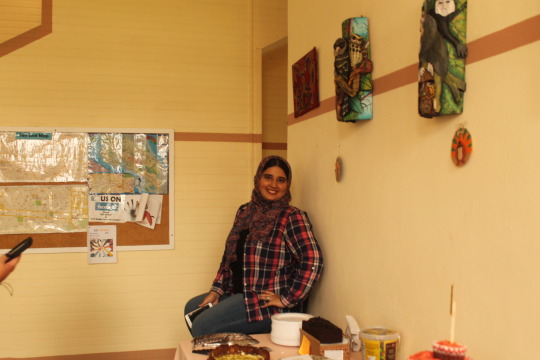
Unfortunately and unjustly, Islam and Muslims are deemed by most of the world population to be the root causes of terrorism all across the world, along with Sikhs and Hindus, who are mistakenly being identified as Muslim due to their appearance. There is no doubt that this is far from accurate. However, a considerable majority of the world's population still blames Muslims and other minorities for many reasons. This is completely unacceptable. The best way to reject this claim of discrimination is to educate ourselves and others. As an open minded individual and LIU Global student, I have learned to embrace differences and bond with acceptance. Through my experience traveling and living as a global citizen, I’ve witnessed the beauty of kindness and helpfulness towards others. It is our utmost responsibility as humans to lead with love, and that is what I plan to do throughout my time here in this world.
1 note
·
View note
Photo
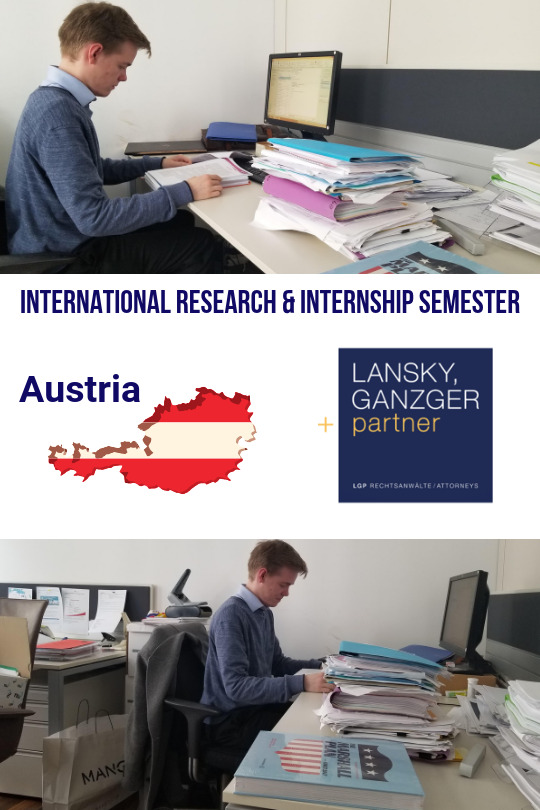
IRIS Interview - Kirby Legget
Where are you interning?
Lansky, Ganzger + Partner Attorneys at Law in Vienna, Austria.
Tell us what your internship organization does.
Lansky, Ganzger + Partner is a top international business law firm based in Vienna, Austria in partnership with law firms across the globe. The firm has some of the leading attorneys in Austria as well as experts on topics including human rights and international relations.
What kinds of things do you get to do on a regular basis at your internship?
I get to contribute to research for the business development team at the law firm. Thus far, I have done research for them about small and medium-sized enterprises in sub-Saharan Africa as well as research about the Lira crisis' effect on foreign mergers and acquisitions in Turkey. The research I contribute to has an impact on the team's projects so I know that I am making a difference in my workplace.
What are some exciting things you've learned at your internship so far?
I have learned the importance of being skilled at researching many parts of the world which LIU Global has trained and prepared me for. I have also learned the importance of human rights advising and advocacy in an international business law firm that I believe leads on those issues.
How is your IRIS internship impacting your thoughts about what you want to do after college?
I am incredibly interested in and working towards studying law and international affairs after graduation to enter the international law and policy field.
Why should future students get excited about their IRIS semester?
IRIS will be a novel experience in your undergraduate education where you will have the freedom to go somewhere and do an internship in a professional field that you are passionate about while researching a topic that fascinates you.
1 note
·
View note
Photo

21 Facts About Gender Inequality You Need To Know About
1. In 2016, just 57 percent world's working-age women are in the labor force, compared to 70 percent of working-age men. Microlending programs like Kiva help women start and sustain their own businesses. (Department of Labor)
2. Women with full-time jobs still earn only about 77 percent of their male counterparts' earnings. Talk about how much you earn, and report inequality. Learn about how to file a charge of discrimination with the EEOC here. (White House)
3. African-American women earn 64 cents and Latina women earn 56 cents for every dollar earned by a Caucasian man. Lean In offers resources for negotiation in the workplace. (White House)
4. 62 million girls are denied an education all over the world, and former First Lady Michelle Obama started shining a light on this issue through her Let Girls Learn initiative in 2015. #UpForSchool wants to continue to fight to change that. Sign their petition here. (UN Foundation; 62 Million Girls).
5. Every year, an estimated 15 million girls under 18 are married worldwide, with little or no say in the matter. Girls Not Brides studies the problem and is working to find workable solutions. They know that education and empowerment for girls are the first steps. You can help by sharing the facts or donating to projects making a difference.
6. 4 out of 5 victims of human trafficking are girls. The Malala Fund raises awareness and funds for girls to get out of this cycle and into school. (Malala Fund)
7. According to the UN Foundation, "At least 250,000 maternal deaths and as many as 1.7 million newborn deaths would be averted if the need for both family planning and maternal and newborn health services were met."
8. On average, 30 percent of women who have been in a relationship report that they have experienced some form of physical or sexual violence by their partner. The National Coalition Against Domestic Violence offers volunteer opportunities, and you can support them at their events by checking their calendar here. (WHO)
9. Female genital mutilation (FGM) affects more than 200 million girls and women alive today in 30 countries. It is recognized internationally as a human rights violation. Equality Now offers specific points that will help you take action against FGM worldwide. (WHO)
10. American women serving in Iraq or Afghanistan are more likely to be raped by a comrade then killed by an enemy, and the rate of sexual harassment reports is higher than ever. In 2016, service members reported 6,172 cases of sexual assault compared to 6,082 in 2015. The Service Women's Action Network helps achieve equal opportunities, protections and benefits for women in the military. Learn about their mission. (Pentagon; NBC)
11. Until recently, women in Saudi Arabia weren't allowed to drive and are still discouraged from working jobs that would put them in contact with men. The unemployment rate for women is 33 percent for women, 7 percent for men.
12. At least 1000 honor killings occur in India and Pakistan each annually. Honor based crimes are distinguished by the fact that they are often carried out by a victim's family or community. The Honour Based Violence Awareness Network includes resources for victims and allies. (HBVA)
13. As of early 2017, 223 colleges in the United States had a total of 304 pending Title IX sexual violence investigations (quadrupled from 2014). Learn how you can help stop sexual assault at It's On Us. (NPR)
14. Women around the world aged 15-44 are more at risk from rape and domestic violence than from cancer, car accidents, war and malaria. (UN)
15. Around the world, only 32 percent of all national parliamentarians are female. That's more than double the number in 1995, but still a marker of slow change. Running Start is an organization that helps bring young women into politics. Learn about their programs and events here. (UN)
16. By 2020, there will be 1.4 million open technology jobs in the U.S. and, at the current rate of students graduating with degrees in computer science, men will outnumber women 4:1. Girls Who Code aims to educate and expose at least 1 million girls to computer science by 2020. Learn more about what they do here. (Microsoft Research)
17. One in five women on U.S. college campuses have experienced sexual assault. End Rape on Campus offers resources for survivors and supporters, working to bring more cases to court and raise awareness. (AAUW)
18. Women currently hold 24, or 4.8 percent of CEO positions at S&P 500 companies. Mentorship programs like Step Up help keep girls in school, getting them that much closer to an executive position. Learn how you can play a part. (Catalyst)
19. More than 43 million people around the world are forcibly displaced as a result of conflict and persecution. Half of all refugees are women. Zainab Salbi founded Women for Women International to help women in war-torn countries build their own futures. (UN)
20. Less than 30 percent of the world's researchers are women. Google has a program to inspire the next generation of tech innovators. Learn how to help girls gain exposure to careers in science and technology. (UNESCO)
21. One in three women worldwide have experienced either intimate partner violence or non-partner sexual violence in their lifetime. Amnesty International pushes for laws that recognize this statistic, and its website has a list of ways to get involved in the change. (WHO).
5 notes
·
View notes
Photo

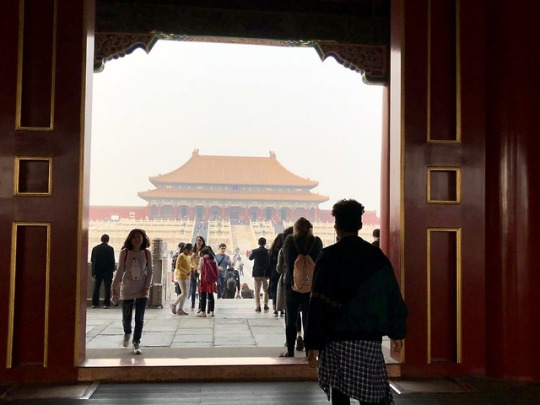
Beijing
by Aaleah Oliver
I had imagined all cities in China to look like the Dongcheng district of Beijing - a mix of traditional Chinese architecture- pagodas and tiled roofing with modern skyscrapers and high- tech facets. But there was more to the area than I had initially realized. The main road ran through a hutong, or a maze-like community with narrow unnamed streets. Though the word hutong can be traced back to 13th C. China as referring solely to the narrow streets between single family courtyard houses, they have come to refer to busy cramped neighborhoods characterized by multi-family homes, and shared public restrooms as a result of rapid urbanization and increased housing demand. In recent years, many Beijing hutongs have been demolished over public health and safety concerns as they are often stigmatized as dangerous and dirty places. Some sections of hutongs have been preserved as part of larger China-wide efforts at cultural preservation in cities although this active preservation finds itself in the midst of a larger debate over what, how, why and for whom certain aspects of Chinese culture should be preserved.

The pavement picked up outside of the barricade disallowing cars and bikes to enter the residential section of the hutong. There, the pedestrian and e-bike only street began, it quickly widened with shops selling elegant qipaos and silk scarves next to shops selling cheap slippers and endless options for food stores on either side eventually making way to the main road, just two blocks from King’s Joy hotel where The LIU Global China Center Students spent our week in Beijing. Every morning, the lobby of King’s Joy would swell with people, from all over of all ages. Many of them, like us, would join the rush hour foot traffic making our ways to the nearby metro station, Forbidden City and Tian’anmen Square.
Tian’anmen Square is a historic gathering place facing the gate to the Forbidden city. It was where thousands of students from all over China gathered to demand freedoms of speech and government accountability in 1989. The students were met with violence, jailed, and many were killed in clashes with police and military forces. The action at Tiananmen in 1989, often called the June 4th uprising, marked a shift in that youth generation who didn’t have a memory of the Cultural Revolution or Mao Zedong. June 4th was a perspective-altering event that disillusioned Chinese youth with their government and the reforms they sought. To enter the Tian’anmen Square area, we walked under a metal detector and put our belongings through a bag scanner. On the Square, plain-clothed police officers walked in between tourists taking photos and group tours. A large flower bouquet sculpture adorned the middle of the square in celebration of China’s National day.
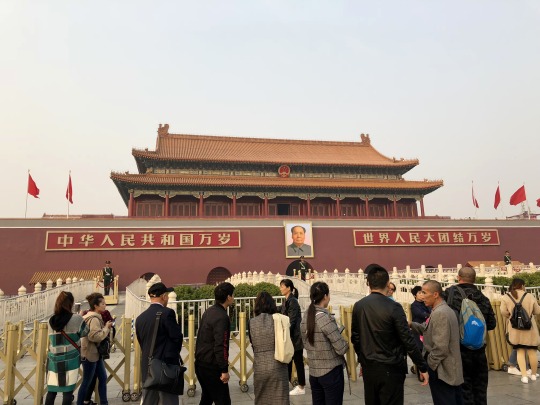
We visited the Square on a clear day and were gifted with sunlight for three whole consecutive days during the trip. But it was during our journey up the Great Wall that the smog made a vengeful comeback. During exercise, you breathe in four times the amount of air that you breathe during normal activities. That meant we’d breathe in four times the amount of smog during our hike up the wall than we had been during our site visits and lectures. Osman, our health and safety guy for the semester passed out 3M medical grade air filtration masks to the six of us students, Lyric our student coordinator and Vivian our program director on the bus ride to the wall. The masks fit snugly over our noses and mouths. They also made it difficult to breathe. By the time we reached the ticket collector, most of us had taken them off.
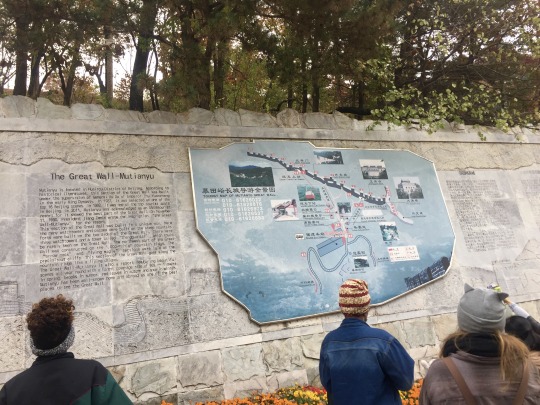
The smog in Beijing has developed as a public health and safety concern over the past few decades in China. With over 300,000 deaths related to bad air quality occurring each year. Though in more recent years, Beijing has been experiencing more clear sky days as a result of stricter environmental protection policies. In partial preparation for the Beijing trip, our Global Studies III: Theories, Issues and Solutions class watched “Under the Dome,” a documentary on smog in Beijing. One moment that stood out to me in the film, was investigative journalist Chai Jing interviews a child who had never seen a blue sky in her lifetime, and who, at the rapid rate of industrialization by any means necessary in China in 2016, might have never known a reality outside of that.
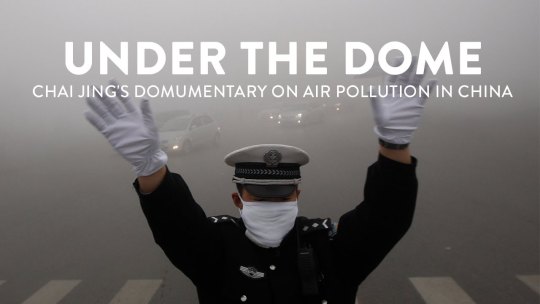
Our visit to Beijing ended in the office of the UNDP, where we spoke with the Program Manager of the Energy and Environment team and his two expert colleagues for Sustainable Development Goals (SDG) localization and youth empowerment and learned about the UNDP’s mandate in China and what the nation is currently doing to eliminate harmful emissions. During the UNDP visit, we learned about hydrogen powered vehicles that produce zero harmful emissions, China’s pilot development program that focuses on sustainably developing the economies of three cities with hopes that the program will be expanded to cities all over China, and the engagement of Chinese youth in environmentally conscious social enterprises. The tone our visit to the UNDP ( United Nations Development Programme in China ) office was overly positive with our speakers generally hopeful of the future of China, despite the time it has taken the country to get there.
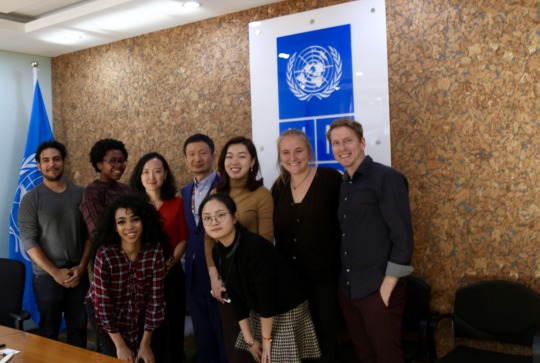
I noticed that absent from the development plans was any initiative directed toward culture, migrant workers or women. I attributed this by and large to path-dependency or the idea that tries to explain the continued use of a model based on historical preference. Historically, women have been left out of national development discussions, as have migrant workers and minority ethnic communities. Contemporarily, organizations are trying to change that.

We met Yiping Cai, an Executive Board Member of Development Alternatives with Women for a New Era (DAWN) in a Beijing cafe on Tuesday afternoon, our third day in Beijing. (DAWN) is a network of feminist scholars and activists who research and document the impact of current trends of development on women in their home countries, participate in discussions and advocate for “ethical and socially responsive development alternatives”. Over coffee, we discussed major issues affecting women in China, one of them being the “leftover woman” campaign -- a state-sponsored campaign aimed at shaming women into marrying earlier, often at the expense of their educational and professional careers as well as their economic and political freedoms.
A lot of efforts of DAWN and the Feminist movement in China is focused on creating spaces for rural and urban women in their governments and societies and empowering them to participate. Yiping Cai introduced to us briefly, the power cube framework, a visual representation of the interrelationships of power dynamics on local, national and global levels.
I found it interesting how forms of power aren’t presented as neutral and are inherently stacked against minority and marginalized peoples. That observation reminds me to survey the power that I have in certain spaces and to make sure that my words or actions do not contribute to the silencing of groups of people or the perpetuation of harmful ideologies.
I ended the Beijing trip holding on to the belief that for communities, nations, and for people, actions can be self-reinforcing, so a step in the right direction, with the right amount of encouragement and accountability, will one day lead to lasting positive change.
0 notes
Photo

Tourism and Politics in Barcelona
by Melissa Vargas
The LIU Global Europe center visited the city of Barcelona, located in Spain’s autonomous region of Catalonia, for four days last month. Academic focuses of the trip included the study of Modernism and Surrealism, the politics of Catalan separatism, and the impact of tourism. An emphasis was placed on understanding the relationship between art, culture, and politics rather than viewing them as separate entities.
Political situation
The streets of Barcelona breathe political air. Everywhere you look, there are flags and political banners. Whether it be the Cataluñan independence flag or the Spanish flag, these flags serve as symbols of a deep-seated identity conflicts.
Personally, I found the topics of politics and tourism most interesting.
Politics

Catalonia has been considered an autonomous region by the Spanish national government since 1979. There are sixteen other autonomous regions in Spain, however, each region’s agreement with the national government and level of autonomy varies. Spain has granted Cataluña the right to self-governance and recognizes Catalan as an official language of the region in addition to Spanish. While Catalonia has been considered autonomous for almost forty years, a desire for greater autonomy and even succession has persisted throughout the region’s history.
At the mention of Catalonia, the first thing that might come to mind is the referendum that took place just over a year ago on whether or not the region should become independent from Spain. Although the Spanish state refused to acknowledge the legitimacy of the referendum, grassroots efforts still managed to make the vote happen. The referendum was met by the central government with violent and punitive responses, most notably raids on polling stations and both the incarceration and exile of Catalan government officials. While Catalonia’s turbulent political climate during the referendum caught international media attention, the coverage was ephemeral. Visiting Catalonia and learning about its history made clear that the region's political unrest wasn’t born when global coverage of the referendum began, nor did it dissipate when the referendum ceased making global headlines.
The city of Barcelona breathes a political air, as distinct political flags and banners stuck out on nearly every street that I walked on. Some banners have messages advocating for the release of political prisoners by the Spanish government, while others simply have the word ‘sí’ printed on them in reference to the referendum vote. The different flags hung throughout the city give insight into the nuanced opinions that exist on the issue of separatism. The official flag of Catalonia is yellow with four red stripes. The popularly recognized Catalonia independence flag, which resembles the official flag but incorporates a white star within a blue triangle, was most prevalent throughout the city. Another flag, with the base of the official flag and a red star within a yellow triangle, also represents independence but has communist and socialist ties. I also saw Spain’s national flag hung as an expression of anti-separatism from time to time. Just walking the streets of Barcelona put into perspective the distinctions that exist even within parties generally in agreeance.
Tourism

Prior to the trip, our class discussed the negative impact of tourism within the city of Barcelona in our Bibliographic Research course. We particularly focused on the comparison of tourists to immigrants, in terms of their contributions to the city. Residents of Barcelona appreciate immigrants over tourists because they contribute to society in a lasting, impactful way. Imagining the specific ways that tourists might negatively impact a city, such as pollution and gentrification, was near effortless. However, one statistic from the Guardian mentioned during our discussion was inconceivable: Barcelona recorded 32 million tourists in 2018, which is 20 times the population of the city’s residents. For this class, we were tasked with being acutely aware of the impacts of tourism on the city throughout our visit and taking field notes on our observations.
There is a large immigrant population in Barcelona and it quickly became clear why the city prefers their presence over the presence of tourists. Over the span of our four day trip, I encountered and spoke with a Colombian woman who works in a shoe store, a Pakistani restaurant owner, and a woman running an art exhibit from Madagascar. The immigrants I encountered are all individuals who are in Barcelona to stay, whereas tourists are not.
The once unfathomable number of 32 million tourists truly came alive upon arriving in Barcelona. Streets, public transport, and famous landmarks are heavily congested with tourists. In our Global Studies course, we’ve been learning about the concept of space and how to analyze it. What better place to analyze space than Barcelona? I found the Barrio Gótico quarter, a heavily commercialized area located in the center of the city, a particularly interesting space to analyze. Contrary to its name, Barrio Gótico is not authentically gothic; the quarter’s medieval buildings were restored in a gothic style during the late 19th and early 20th centuries in order to appeal to tourists.
As I walked through the quarter knowing its history, I couldn’t help but feel like I was walking through an artificially constructed space. Endless modern shops and restaurants, nestled along cobblestone alleyways and next to large gothic buildings, seemed rather incongruous. The quarter consists of many tall buildings with balconies overlooking the narrow streets below. From these balconies hang independence flags and political banners. While independence flags were hung from a minority of the balconies, the symbolism of these flags exudes a very political climate into a space largely occupied by tourists. It was interesting to see small, spatially elevated expressions of residentiality and local identity juxtaposed with the predominantly tourist-filled space below. It’s difficult to imagine, as a local, looking down onto a space every day that tourists dominate.
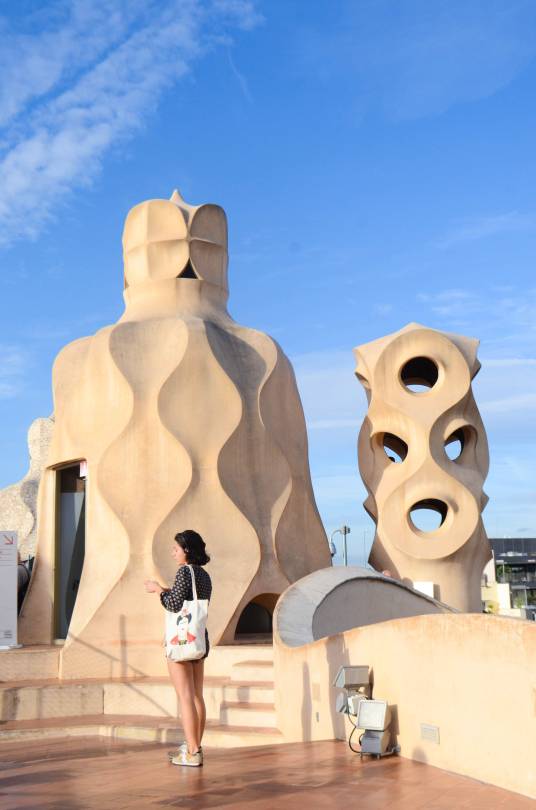
While there isn’t a simple solution to the issue of tourism in Barcelona, witnessing how tourists can negatively impact a society causes me to question my role as a traveler and think more deeply about the way I may be affecting a city when I visit it.
0 notes
Photo
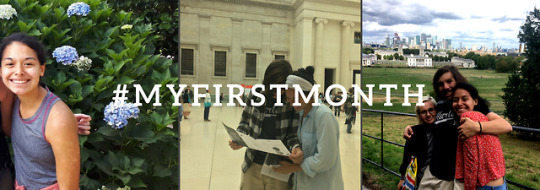
My First Month in Spain with LIU Global
By Melissa Vargas
I have been living in Alcalá de Henares, Spain for about a month now. While we are housed in dorms at the Lope de Vega residency and attend classes at the University of Alcalá Franklin Institute, our campus is in no way defined to these two locations; the city of Alcalá de Henares serves as our campus. There is always something going on in this city, whether it be medieval festivals, farmers markets, art exhibits, or religious processions. Brimming with culture and history, the city provides so many awesome opportunities for immersion and learning and my goal this semester is to take full advantage of it.
As with most experiences living abroad, moving to Spain has involved a bit of culture shock and adjustment. The biggest adjustment for me has been the transition from living with a host family in Costa Rica last year to living in a dorm with 400 other international students. While the newly built residency’s facilities are incredible and living in a dorm allows for much more independence, having a host family gave me so much unique insight into the local culture in a very intimate way.
Because the residency provides all of our meals and has pristine quality study areas and recreational facilities, it’s easy to fall in the habit of spending more time in the dorm than in the city itself. Living in a residency doesn’t eliminate immersion opportunities, but rather just requires a bit more of a proactive effort to engage with local people. I’ve been trying to spend more time in the city by doing small things such as doing homework in a local cafe, eating ice cream in the park, or going for a run to get a better sense of all that lies outside of the residency.
Some other things that I’m still getting accustomed to are the type of Spanish spoken here and meal times. Castilian Spanish varies from the Latin American Spanish that I am used to, particularly the use of vosotros and the pronunciation of c and z as a th sound. As for meals, Spaniards eat much later in the day-- the residency begins serving dinner at 8pm on weekdays and 9pm on the weekends. I sometimes find myself counting down the minutes until dinner with a growling stomach, but I’m slowly getting used to eating a later dinner.
In regards to language immersion, two of my classes are taught in Spanish. This has helped my Spanish comprehension more than my speaking ability, as these classes don’t always require a large amount of verbal participation. I’ve found that just like exploring Alcalá, practicing speaking regularly also requires a concerted effort. I hope to practice more Spanish by participating in a language exchange organized by our host university and at my internship this semester.
Our school trips so far include visiting Santiago de Compostela in Galicia to walk El Camino and day trips to the capital city of Madrid. While these trips have given me insight into other parts of Spain, I still have a lot to learn about Alcalá and look forward to the rest of this semester.
0 notes
Text
El Camino by Melissa Vargas

Just one week after touching down in the Spanish city of Alcalá de Henares, a UNESCO World Heritage Site that we are lucky to call our very own campus, the students of LIU Global’s Europe center set out for Spain’s northwest community of Galicia to commence walking the Camino de Santiago. The early morning five-hour train ride to Galicia carried us away from the urban hustle and bustle of the greater Madrid area, as we coasted along vast farmlands and quiet villages.
The Camino de Santiago, more commonly known as “El Camino”, is a pilgrimage walk leading to the magnificent Cathedral of Santiago de Compostela where the apostle St. James is thought to be buried. During the Middle Ages, most pilgrims had religious motives for completing the Camino, particularly the promise of total redemption from all sins; nowadays, the walk has a variety of non-religious meanings for people from all walks of life.
The Camino consists of various routes spanning both throughout Spain and across surrounding Europe. While the cathedral serves as a definite marker of the walk’s endpoint, both the route and total distance walked are unique to each person. Our class walked forty kilometers through the towns of Arzúa and O Pedrouzo over the span of two days, but others sometimes dedicate an entire year to walking much longer routes.
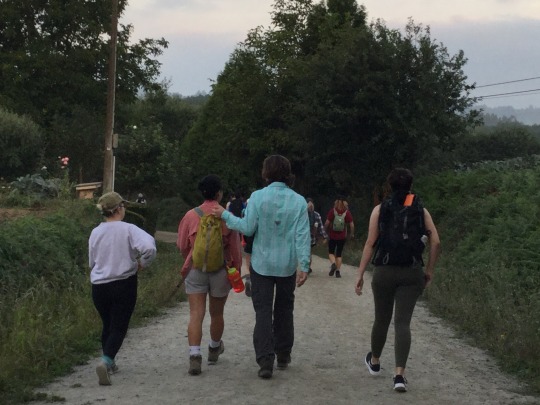
The Camino holds a different meaning for everyone that walks it. My classmates and I sought out to explore both what significance it holds for us, as well what it means to others walking. The walk is very much a no-frills experience: basic hostels, limited access to technology, and fitting all your belongings into a single backpack. Nevertheless, the lack of luxury is precisely the reason many people are drawn to the journey. The Camino exemplifies how instrumental forfeiting material concerns can be in creating an authentic space for internal reflection and meaningful interaction with others.
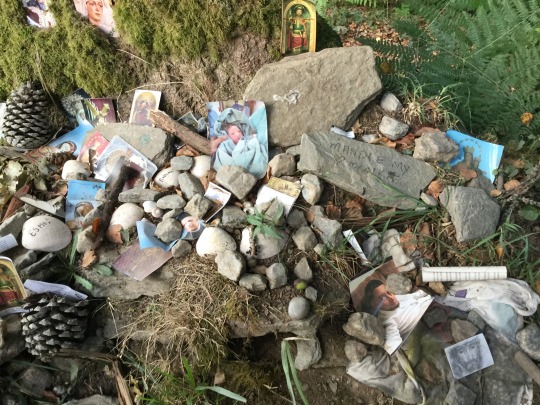
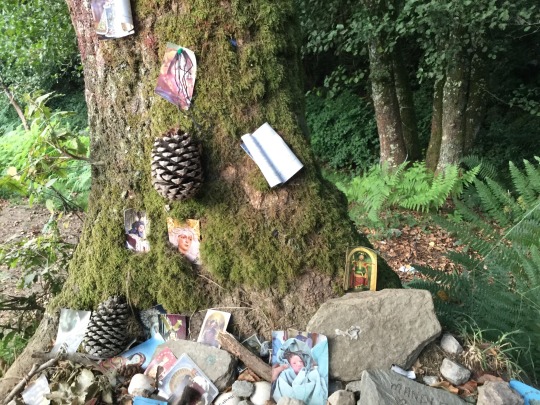
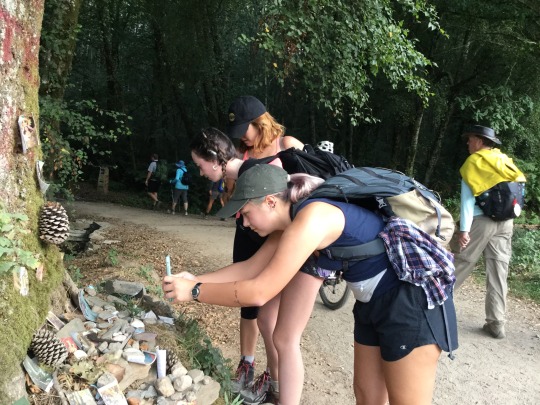
Just as each morning’s crisp air and morning dew eventually faded as the day went on, my discomfort and often trivial concerns dissipated as the days of walking progress. I instead became absorbed by the scenes of small brightly colored homes, farm animals, beautiful flora, and messages of encouragement scribbled everywhere. One message read, “viajar abre la mente”, which translates to travel opens the mind. While quite simple, I think this message truly embodies the Camino’s spirit of mental growth. The walk’s long dirt trails guided me through lush farmland and rich forests, but more importantly to an untapped mental space of reflection and gratitude. The journey gave me both the time and space to reflect on the past couple of months of travel throughout Europe and appreciate how fortunate I am to immerse myself in global experiences as meaningful as walking the Camino.

The Camino held a special meaning for each and every member of the LIU Global Class of 2021. Classmate Lilli Hoffman also found the experience to be a meaningful space for reflection. She says, “It was a time that I could spend a few days in nature quietly reflecting on the year previous and the year ahead. It made me feel like I was part of something a lot bigger than me, something that millions of people had walked before me. Just walking brought me a lot of clarity and made me want to go back and do a larger portion Camino in the future by myself.”
For Skylar Silvera, the Camino’s spirit of community was most meaningful: “Meeting people from all over the world, learning about different beliefs and hearing stories about loved one's travelers dedicated their pilgrimage to, was such a beautiful experience that I know all of us to cherish deeply. Now I get to look back on these miles and think of the many before me that yearned to journey outside their tiny villages to seek a greater unknown, and feel lucky that I get to do that every day with the best people.”
While the Camino meant something unique to each of my classmates, I’m sure the experience will never fade from each and every one of our memories. In fact, many of us hope to return one day and challenge ourselves with a longer route. Before attending LIU Global, the Camino was something I had always heard about but never thought I would ever realistically have the opportunity to do. Needless to say, the Camino was such a meaningful addition to the Spain program this year and surely will continue to be in the years that follow.

3 notes
·
View notes
Text
A Day in the Life
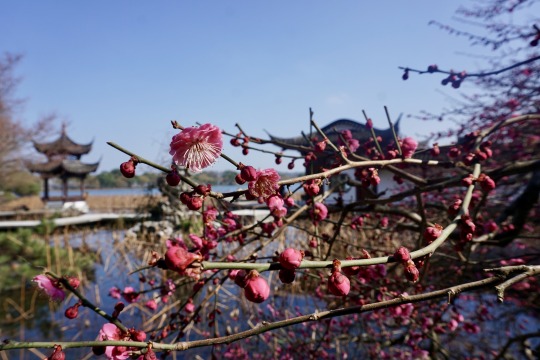
I wake up to the sound of e-bike alarms; it was also my lullaby, and I’m becoming oddly attached to it. Today is Wednesday in Hangzhou, and the students of Zhejiang University Yuquan Campus are ready for it to be Friday. It’s not that we don’t like our classes; this is, after all, one of the top universities in the country, and it shows in the academics and campus. Rather, we are hoping for Friday to reward us for our hard work with more seasonable weather and a possible win at trivia night. As of now, nine in the morning, it is stressfully hot and even more humid.
The food here is delightful, as rather than a sit-down meal of hit-and-miss eggs like I would have in the States, I grab some steamed pork buns, the breakfast of champions and the Chinese. Vitamins are rare in the meat- and bread-based meals here, so I grab a mango-orange juice and pretend it’s healthy. Wednesday morning, for me, means meeting with my counselor to discuss my Junior Research Seminar work, so I sally on up to the balcony and log on to Zoom for my appointment. On the way, I pass people speaking Mandarin, Korean, Arabic, Spanish, English, and what I presume to be Swedish.

China Center students are notorious for not leaving the bubble, but when you take a look at the variety of humanity spilling from the doors of the International Dorm, it’s easy to understand the temptation of just making friends here. As far as many Global students are concerned, China is here, in ZJU’s building 30.
Wednesday afternoons are a doozy for me. The second I wrap up my meeting, I must procure lunch and hustle over to the Center, and upstairs room in a building fifteen minutes from the dorms. This campus is truly enormous, and I have yet to even walk from one end to the other. I pop across the street for some beef and potato curry with rice, da bao (to go, minus the tones) because I don’t have time to relax. This is my favorite part of the day, walking through campus in anticipation of a challenging yet rewarding class, hot lunch in my hand; I build in an extra five minutes so I can walk slowly. ZJU Yuquan campus is lined in trees, green places to relax, mom and pop convenience stores, and rows of yellow bicycles you can borrow for free, if you’re in a hurry. These bikes are all over the city and are outrageously convenient, yet another example of Chinese efficiency, along with paying for everything, and I mean everything, with your phone, and adequate bike lanes. Hangzhou has about ten million residents and hangs, many days, under a layer of smog; when it rains, you are strongly recommended to use an umbrella, lest the chemicals in the rain cause your skin irritation. Still, despite the smog and the humidity, this campus is filled with trees that make the air seem crisp and fresh. By the time I arrive at the Center, I have a pep in my step and a banana I picked up at a fruit stand, ready to start class.
With Global College, I have taken either intensive or survival courses in the following languages: Spanish, German (just key phrases), Darija, Italian, and Bosnian. Nothing prepared me for Mandarin. It’s just the tones, they’re a real game changer. The first tone, like you, could care less, the second tone like you’re mildly surprised, the third tone, as though you are wholly incredulous, and my favorite, fourth tone, like someone just punched you. In theory, it should be easy, but English is a language that relies heavily on intonation for meaning, and I personally have some bad habits. The most egregious is the California Upswing, that pesky habit of ending every sentence on an upward tone like I just asked a question? Most recognizable in Southern California valley girls, I am ashamed to admit that we, too, have it in the North.
Qingqing Laoshi (Sunny Teacher) is unimpressed. Qiaokeli, she says, are you saying can I have some water, or can I have some sleep? Both are shui, and I just can’t wait for class to end so that I can put my notes on flashcards and practice until I no longer feel helpless. We have a grand total of fifteen minutes between the end of class and the start of Junior Research Seminar, so I chow down on my Chinese-style beef curry, filled with cinnamon and perfectly cooked potatoes. I might miss that curry place more than I miss some of my new friends, because food is the best friend I will ever have.
JRS is a breeze as always, with spirited conversations on research ethics and no shortage of connectivity problems. Finding adequate internet in China is always an adventure. As class comes to a close, we disperse, and the day is ours. Some will nap, others will ride bikes to the lake, find a patch of grass, and nap. Let’s be honest, at some point, everybody is going to nap. I save my nap for later, heading to my favorite local café to study and drink a well-deserved milkshake. Later, I will spend an hour calling family so that they know I’m not dead, and perhaps for dinner I will practice my Mandarin on the street noodle vendors. When I feel I have completed as much work as I wanted, I will meander over to a local bar where all of the bartenders are South African and the tiny Chinese girl who fronts the house band is always crooning George Michael hits. I do not go to drink, although I may indulge in a chicken quesadilla; I go to spy on the local fauna. People watching is, without a doubt, my favorite part of living in a large Chinese city, and a consistently uplifting way to end a school day.
If you made it this far, I applaud you. While it may seem that this piece was merely an exercise in ego, let me assure you, I had a point. Through my florid prose and unnecessary asides, I wanted to convey this: China, and the Global College China Center, are different from anywhere I have been to date, but a Wednesday here is still just a school day. Every day of college is made up of a series of seemingly trivial components. It is the individual quality of those components that comprise the spice of life. Each day here is both predictably normal and spectacularly exciting. I can only hope to portray even a sliver of that in my writing.
by Julia McCoy
0 notes
Text
Yunnan and Sichuan Dreams
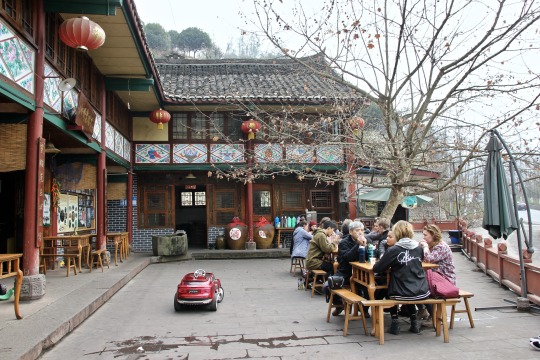
I was sitting in a noodle restaurant in Shanghai, one Saturday before we were set to leave for this legendary trip when I started coughing. It’s no big deal, I reasoned, these peanut butter noodles are spicy and there’s pollen in the air and plenty of smog, so surely the tickle in my throat is only that, nothing sinister. We live in a fair world, so there’s no way I could get a cold right before the amazing trip to the Yunnan and Sichuan provinces I’ve heard so much about.
It was a nasty cold, and I was banished from the trip.
I spend a week and a half alone, healing slowly, drinking buckets of water, and dreaming of the adventures my classmates were having. I was healed when they returned, and I eagerly cornered them and demanded stories. I began with Kate and Emma, shoving my phone in their face as we waited for our noodles.
Kate Yachuk: We talked to Professor Wang, I think, and he told us about the last living hieroglyphic language in the world, which is spoken by thirty people, of which he is one. He was one of the Yi people, he was super friendly and very knowledgeable. And he brought us to his house and gave us lots of candy!
Now, ask any Tom, Dick, or Harry, they’ll tell you how much I love candy, but what I love even more is linguistics. It drives my friends insane, but I’m proud of how truly nerdy I am. One of the main, nerdiest reasons I was so gung-ho for this particular field trip was to personally observe the culture of the Mosuo people, one of the last matriarchal society in the world, with whom I have been fascinated since I was ten years old. The Mosuo live around Lugu Lake, and Emma gave me the briefest of fill-ins on the matter.

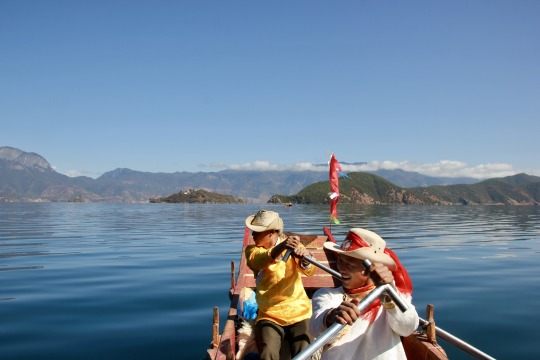
Emma Barker: So, since we had to turn around and not go to the Tibetan village, we had to pull some strings, I think. We were going to the Lugu Lake anyway, but we had extra time from the change of plans, and Liu Wei said he had a friend nearby. We went and visited her house and talked about her culture and then we visited a monastery. We walked around there and were shown around by some monks and a living Buddha. Then we went back to this lady’s house and she wanted to dress us up in some traditional clothing; first we dressed up Zack and Samudra, then we roped Lyric and Liu Wei into doing it too. Everybody looked really good!

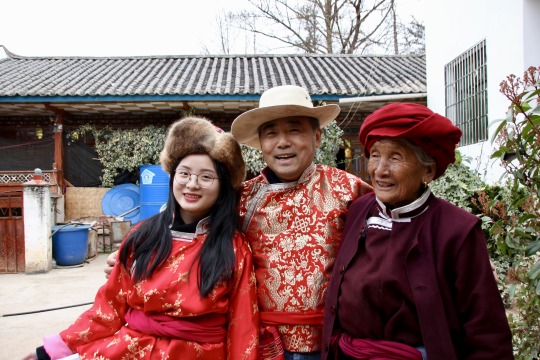

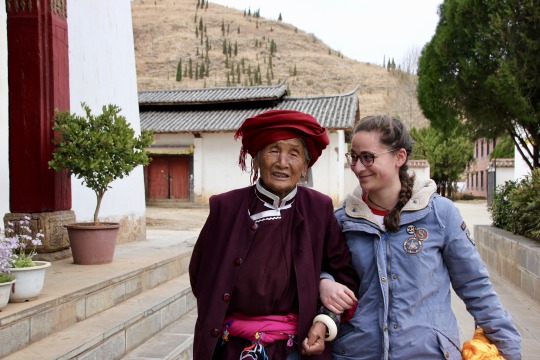
Jealous as I was hearing of Emma’s adventures, I continued to seek stories of the trip. I knew, from years of Global College field trips, that the programming frequently outshone the way it was described on our itinerary, like the way the performance in Taiwan was explained to us as mere children’s theater. Sophie confirmed my beliefs.
Sophie Gagnaire: So, on the trip we met this Naxi woman and she took us to a monastery where her brother works, where we met the living Buddha. I was really blown away by how decadent and extravagant it was. The monastery was in this compound that also had a four-hundred-year-old building, so we got to see these original wall paintings from four hundred years ago, and this massive, thirty- or forty-foot Buddha statue. It was amazing!
One of these things that most clearly marks a Global College field trip is the last-minute adjustments. It is not that Global is unprepared; quite the opposite, in fact. It is rather than a field trip of this nature, twenty foreign students attempting to experience something meaningful in the same place, year to year, lends itself to mishaps and unexpected schedule adjustments, and Global is admirable in the way in which it adapts to such itinerary shifts, and the way in which its students learn to adapt and participate.
Santiago Sanchez y Lucero: So, we drove seven hours into the mountains to make it to the Tibetan region [of Yunnan province], and about six hours in, we ran into police officers who told us that we had to turn back because we were arriving on the tenth anniversary of an uprising that was orchestrated by American student. We seemed like a suspicious group, which I guess is fair.
I caught up with Nicole after I spoke to Santi, asking if they ever did come into contact with Tibetan culture. We were all, at least in our late-night pre-trip debates, keen to engage with Tibetan culture, given that this may be our only chance. We are, after all, a crew of liberal arts students from the United States filled with radical ideas and a truly American inability to censor ourselves when it is appropriate.
Nicole Price: I forget which day in the trip this was, but it was a few days into our trip, and we visited a university where they have an entire portion dedicated to Tibetan language and culture. We got to see their archives of Tibetan language and culture, and also other minority languages that have almost died out, like the Yi language. It was really cool because we got to enjoy a perspective, through these archives, that not a lot of people would have access to. It was exciting to see in practice the things we had been learning about all semester.
Now, Global field trips are, first and foremost, about learning; after all, we wouldn’t be going into this much debt for a degree if we weren’t being provided an excellent education. Still, I spent most of my childhood at summer camp, and I have noticed some close similarities between a day at camp and a day on a Global field trip. Many similarities are superficial, such as the odd sleep schedule, unusual group activities, and the way you seem to fit more into one day that you would fit outside of camp/field trip in a week. What stands out the most, though, are the ability you develop to adapt, at lightning speed, to adversity, and the degree to which you bond at dinner time. At camp, social life revolves around the dining hall, and in the mountains with your Global classmates, you feel the most like a wonderful family when you’re swapping food and stories and recounting your day over more food that you could ever finish. Courtney-Lynn agreed wholeheartedly.
Courtney-Lynn Mellina: My favorite group dinner from the Yunnan trip was the Tibetan-style dinner we had with the living Buddha and the rest of the class. It was, by far, one of my favorite dinners in all of Global, and the food was spectacular! I made some new Tibetan friends, we had great conversation and I tried foods I had never tried before It was a real sense of community that I’m so glad I was a part of.
Now, in spite of certain commonalities, every trip is different. I love taking the things we learned in the classroom out into the field, and I know many of my classmates feel the same. It’s always exciting to find a new way of learning, exploring areas made accessible to you only by the luck of going on the trip; I hope my jealousy isn’t coming through in my writing, I’m not bitter, I’m fine, everything is fine. Sophia and I caught up over dumplings.
Sophia Cox-Wright: One of the highlights, definitely for me, going on this trip would be that, because of scheduling matters and some things, logistically, that just ended up not working out, which kind of just happens sometimes on Global trips, we got a bit more time to just hang out and be alone. It gives you a chance to just learn from the place that you’re in. For example, one of the things that I really enjoyed was going in to the town square in one of the villages and just sitting there and watching the tourist trade and Chinese tourists. It was interesting seeing the effects of it, if that makes sense, and seeing it for myself instead of just reading, trying to integrate myself into that space. That experience is definitely something I’m going to be thinking about for a while.
As I gathered these stories, both for the purposes of writing and personal gratification, I couldn’t help but compare them to the looks on my classmates’ faces when they returned and my own past experiences. This trip to Yunnan and Sichuan provinces was as intense an experience as promised, and like any field trip, the best and the worst part was coming home. After all that you learn, you just want to be somewhere comfortable to process it, even if that means leaving beautiful new places you have become attached to. By taking part in the post-trip emotional processes of my friends, I enjoyed the trip in my own way: vicariously. Until I have time to visit on my own, that will have to be enough.
by Julia McCoy.
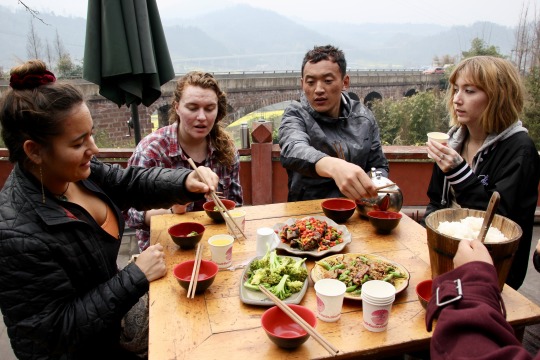
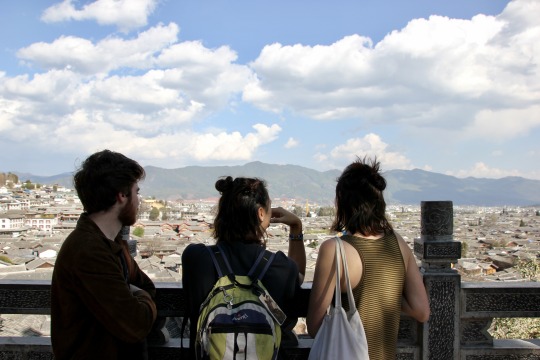

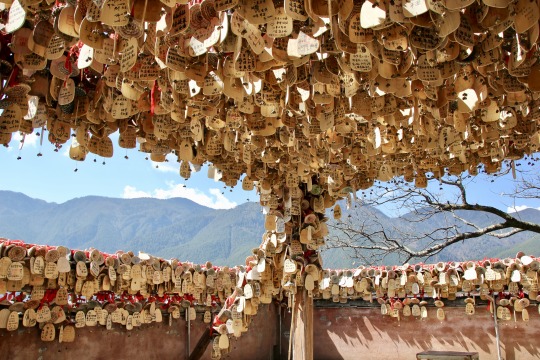
4 notes
·
View notes
Text
The Rome International Careers Festival

In March the LIU Global Europe center students boarded a high-speed train at Santa Maria Novella Station in Florence and a couple of podcasts or a nap later arrived in Rome for a week of experiential learning.
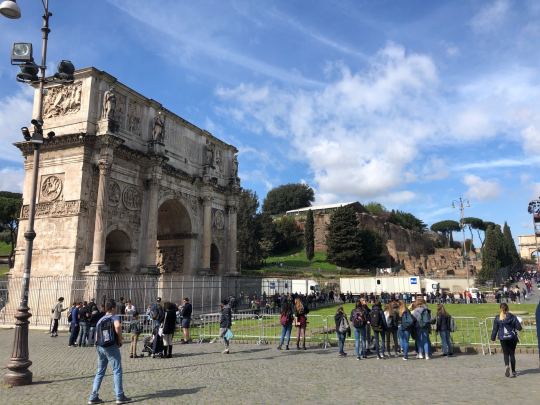
The Rome International Careers Festival takes place each year over the course of four days. Participants have several options for how they want to compete. Some students choose to engage in a model United Nations conference, one of the largest in Europe. Others participate in the Business Game, working with teams of other international students to develop and present ideas relating to present moment business situations. Other students choose the Press Game, which gives students a chance to act as journalists reporting on the rest of the conference. On some of the days of this conference, there are also workshops and a job fair for students interested in an international career. I discussed the Rome International Careers Festival with two LIU Global student participants: Sam Becker (Rome Business Game Winner) and Regina Olivares (Rome Press Game Translator).
Why did you choose to participate in the conference?
Sam: I chose to participate because it was able to open my eyes to the business realm and how businesses handle themselves when faced with conflicts that need to be resolved.
Regina: I chose to participate in this conference because I am interested in possibly working as an interpreter or translator in the future. I also knew that it would help my English and Spanish to do this sort of workshop.
Also, it was paid for by the school so I figured I would take advantage of this experience.
What was your favorite part of the conference?
Sam: I really appreciate that I was able to work in a team made up of delegates from seven different countries. The international interaction was truly an impacting experience that allowed me to leave the festival with a greater appreciation for international relations.
Regina: I participated in the translation workshop. My favorite part was when I got to practice simultaneous interpretation. I messed up a lot, but I learned a bit about where my strengths and weaknesses lie in both Spanish and English. It was interesting to see and try my hand at something professionals seem to do with ease. I also enjoyed going around to interview people participating in the career festival that was going on at the same time and then translating the interviews.
What was the biggest challenge you faced at the conference?
Sam: It was hard being one of the few native English speakers because when it came to presenting my group ended up finishing our presentations faster than any other group when we had the same amount of information if not more because the two native English speakers were able to articulate what we were talking about with a lot more ease.
Regina: The simultaneous interpretation was the biggest challenge for me. I felt as though the simulation was unorganized, but it's understandable because there was so much going on.
Would you recommend the conference to future students?
Sam: I would recommend it to future students because it is an experiential way to learn about something that we do not really get to learn about within global. It also really allows you to make worldwide connections that can be beneficial in the future.
Regina: I would recommend that future students that speak any language other than English try out the translation game. I did learn a lot and it was cool to see other women translating into multiple other languages. I did not have much interest in the other simulations taking place so I am glad the translation game was an option.

0 notes
Text
Srebrenica, Among History & Beauty
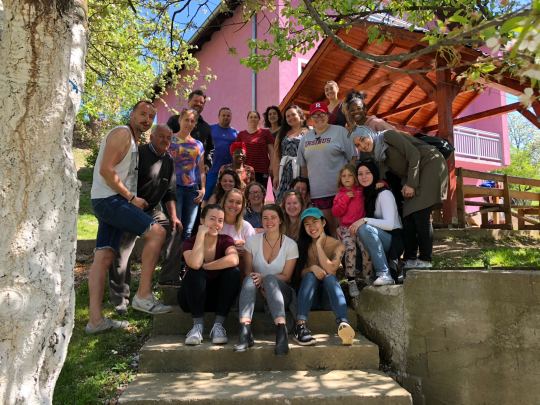
For me, the most important part of my education with LIU Global is the experiential learning. Reading theory may be necessary, but nothing can compare to the impact of going into the field and learning directly from people’s lived experiences. During the last weekend of our Europe semester, we ventured by bus from Sarajevo, Federation of Bosnia and Herzegovina to Srebrenica and Klotjevac, Republica Srpska.
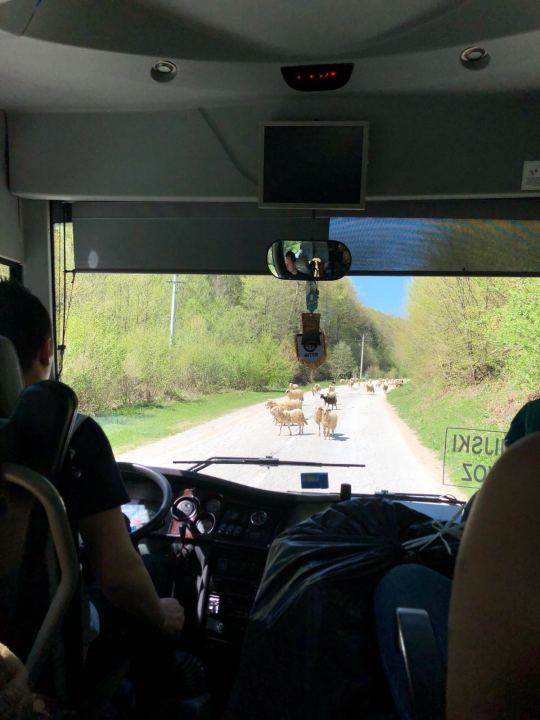
This region was the setting of the genocide in 1995 in which around 8,000 Bosnian Muslim men were massacred.
On the first day, we visited the memorial in Srebrenica. There we learned directly from a tour guide who was a survivor of the genocide and had lost several family members there. He told us about his personal experiences and about the failure of the UN and the international community to help.
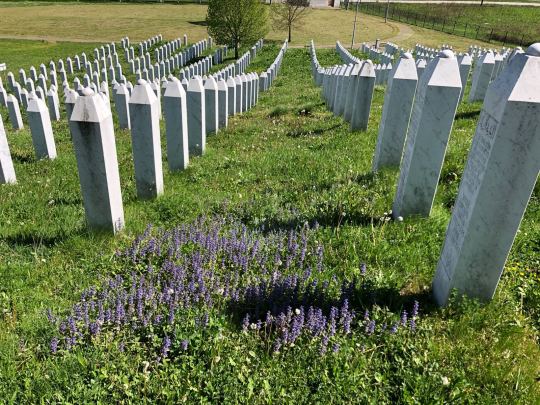
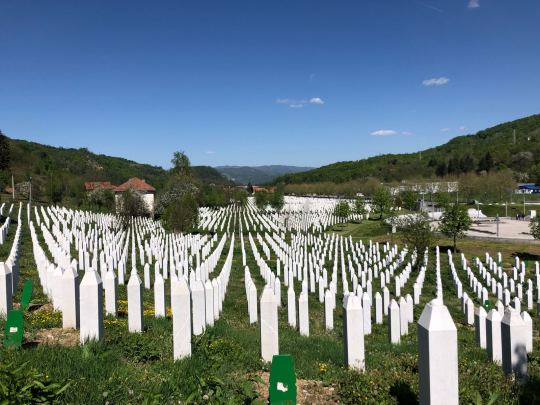
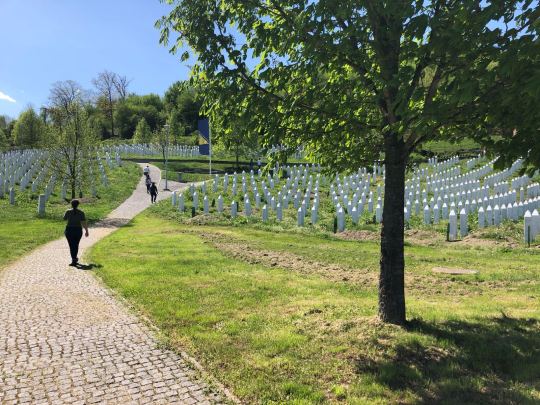
After this, we continued on to the smaller community where we would spend two days and nights. We stayed in the home of one of the few returning families there. Three generations lived in a bright pink house, parents, grandparents, and three young daughters. They welcomed us with a feast of rice, peppers, fresh homemade cheese, and delicious stuffed pies. They live right on the water, surrounded by the staggering mountains. Everywhere we looked was a variation of vibrant greens and blues. The intensity of the beauty seemed to match the intensity of the horror that took place there.
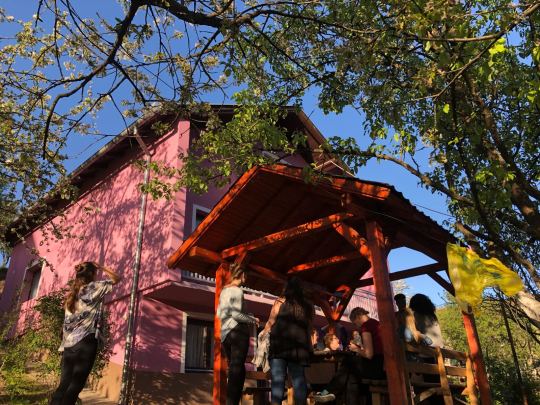
Over the course of several days and meals and walks with the family, they told us much of their story. On the first night walking with the grandfather of the family and several other Global students, he pointed out to us each place where another house used to be.
As the family did not speak English and we could not communicate further than a general greeting in Bosnian, we relied on the help of our organizer, Nerkez, as well as several Bosnian students who joined us. Luckily they were all always willing to translate so we were able to communicate and learn a lot from the family. They shared with us how their income mostly comes from various farming and agricultural pursuits, and hosting student groups like us. There are still many challenges to life in this region though.

During a walk one morning we saw where children in the town used to go to school, yet now the nearest school to this family is quite far away and in danger of closing due to lack of students. Already it is hard to get to it, as the road leading there is bumpy and in need of maintenance. If this school were to close it is possible the family would have to move because in Bosnia and Herzegovina homeschooling is illegal and all other schools are simply too far away to commute to.
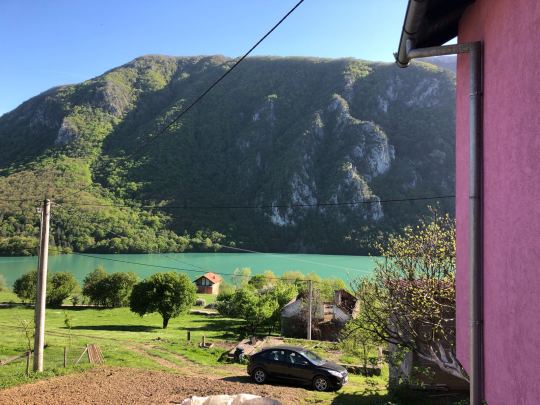
Another challenge they are facing is complications with the government of Republica Srpska. The government of Republica Srpska is dominated by Bosnian Serbs, while the families who were impacted and are now returning to Srebrenica are primarily Bosnian Muslims.
One way the government is impending in the efforts of some families to return is by naming the area a national park. Already they have begun to declare it, but if the process continues it could become legally impossible for more families to return and rebuild their houses and it could even escalate to a point where the families who have already returned must leave again. In effect, the efforts of the government of Republica Srpska to turn the region of Srebrenica into a national park could be seen as a perpetuation of the ethnic cleansing of Bosnian Muslims.
After this trip, we returned to Sarajevo with more questions to ponder than answers. Perhaps this is the clearest sign of a truly impactful learning experience.
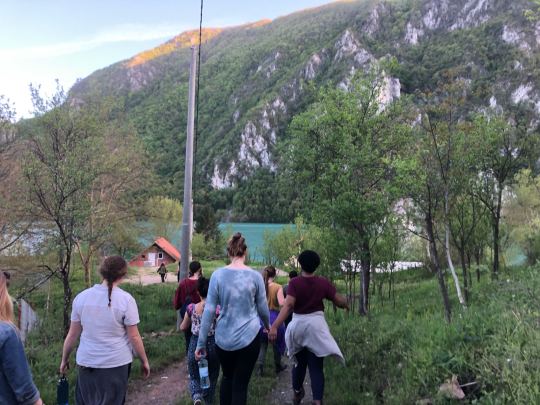
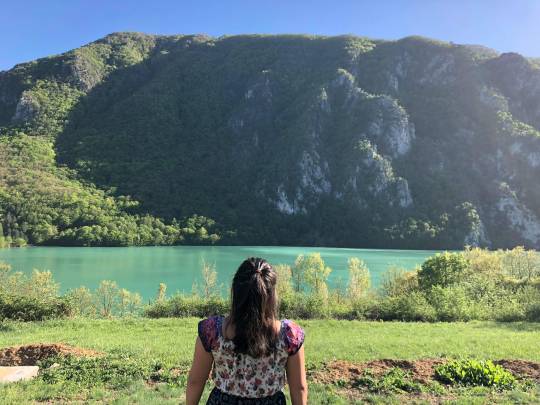
0 notes
Text
3 Months in China

Over the course of two years traveling with Global College, I had developed a very specific arrogance. In our classes and in our daily conversations, we would explore our strengths as international students; we read about cultural literacy and worked through our culture shock eagerly. After eleven countries with school alone, I was convinced that I could adjust to anything; after all, no one can truly avoid culture shock shutting them down briefly, but I knew what to expect, right?
Then I came to China.
I chose the China Center over Australia for my Junior year for two reasons. First, the classes were more suited to my interests, with focuses on cultural relations and business, as opposed to environmental concerns and alternative pedagogy. That being said, all of these topics are covered in every Center; it’s an extremely well-rounded education. Second, I chose China because of the rave reviews. Every one of my peers who had spent time in Hangzhou had raved about the program: the classes, the campus, the Center staff, and the city itself.
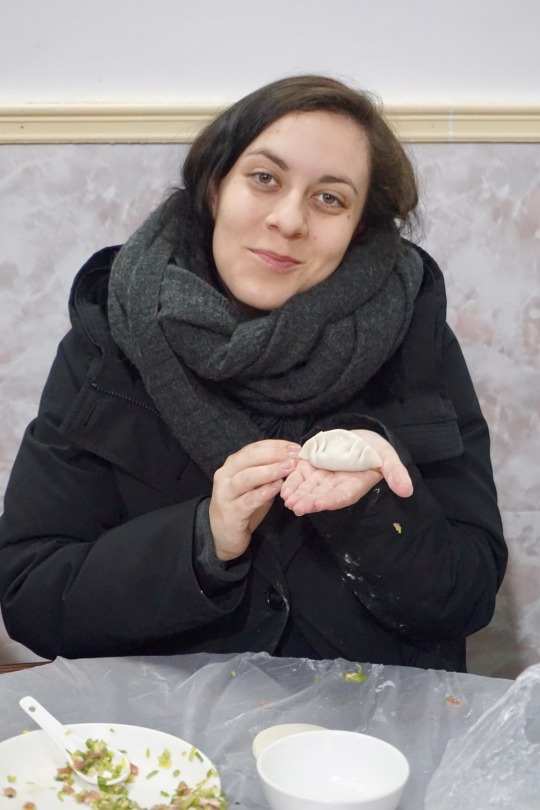
They had also cautioned against biting off more than you could chew, indicating the program to be difficult in the best ways, forcing you to grow and learn every day. Having just taken a semester off, I was looking for a challenge, and I arrived in China with an equal mix of excitement and aforementioned arrogance that, with my enthusiasm and determination, I could overcome the alienation of a new country and thrive. I was wrong, we were all wrong. But being wrong was the best thing that could have happened to us here.
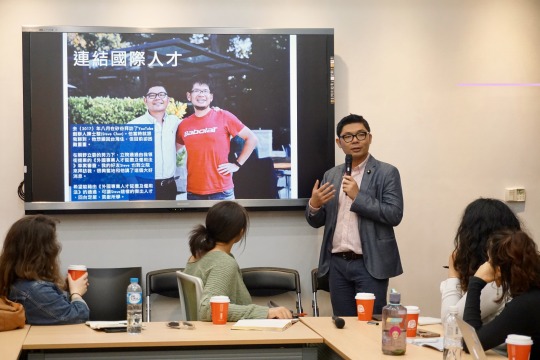
To a ragtag group of Western weirdos who have never been to China, as most of us had not, China is not a foreign country, it is a foreign planet. For once, you cannot get by with broken English and gestures, and when you go to learn the language, it is like nothing you have ever seen. The food is a whole new set of tastes and rules, and interpersonal interactions are like playing the piano blindfolded and hoping the sounds you make won’t upset the audience. The nightlife is thrilling, and the classes are demanding. At the end of the day, you would think an experience such as this would be unpleasant, but you would be wrong. Coming to Hangzhou is an adventure every day. Sure, there are days when we miss you, and no one was truly prepared for the difficulty, but I have learned and grown more every single day here than in the seven months I took off from school, combined. Some experiences have truly shaped me.

One facet of Chinese culture that has left a strong impression on me is how humans interact. Prior to this, I knew that I enjoyed large cities due to the anonymity they afford; millions of people are far too busy to care what you do, and you are left free to do as you please. My experience of China has taken that to a whole new level, although that may be a symptom of the sheer size of Hangzhou. Hangzhou has a population of 9.5 million people. For some perspective, that is nearly eleven times the population of San Francisco. Still, in China, you can do absolutely anything you please, so long as it is not illegal, and no one will notice until you address them directly. As much as I love this, it is the flip-side which I enjoy more. If you enter a Chinese person’s space and engage with them, be it in their shop, their restaurant, their house, or just their daily life, they will welcome you as family. They learn your name, they tell you jokes, and they worry if you seem out of form. In a program where we have only each other as family and a nine- to twelve-hour time difference between us and our support systems, the care of strangers means absolutely everything.
Please note, the familial feeling does not extend to taxis. A cabbie will yell at you, full-volume, if you cannot say your destination in Mandarin. I would consider this to be affectionately rude, as they truly care about you getting where you need to go, and I find it charming.
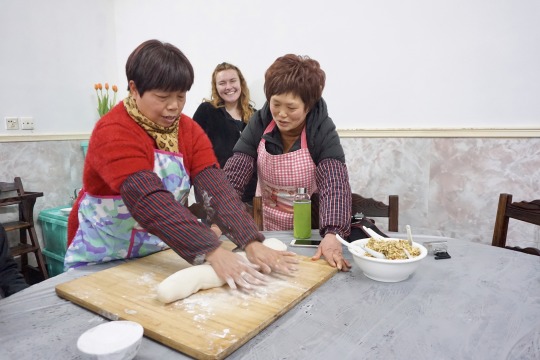
Though Hangzhou is massive and mostly concrete, there is beauty to be found. Ride a bike over to the lake and enjoy a picnic on the shore or reward yourself for finishing that big essay with a trip to the botanical garden. There is some pretty impressive architecture to be found, and a river down which you can ride a water taxi with the regular commuters. I have spent countless caffeinated hours in the many adorable cafes near the university, taking in the carefully curated atmospheres: one with scribbled notes on the wall reaching as high as a student with a marker standing on a chair, another with a friendly little dog to cuddle you and extremely creepy art painted on the ceiling. There is music, and art, and apparently kitten cafés, though I have yet to go. It is sometimes difficult to focus on school in this whirlwind of cultural discovery, but one must.
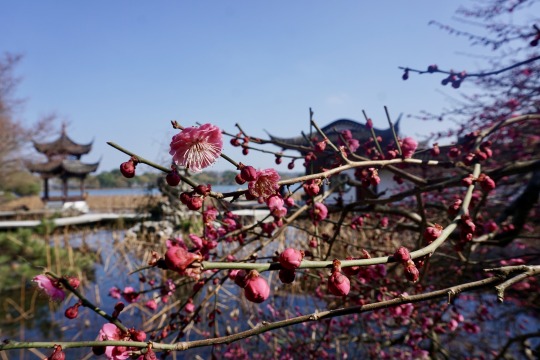
As I prepare to leave China, I know that far more than even this amazing city, I will miss the China Center staff. From some of the most fascinating professors, I have ever had to a crew who supported me, supported all of us, through some of the toughest months of our lives, they have made China everything I was promised. And even though Hangzhou knocked the arrogance clean out of me by force, I am the better for it, and I will always be grateful. I know that one day when I am prepared to be humbled again, I will return.


0 notes
Photo
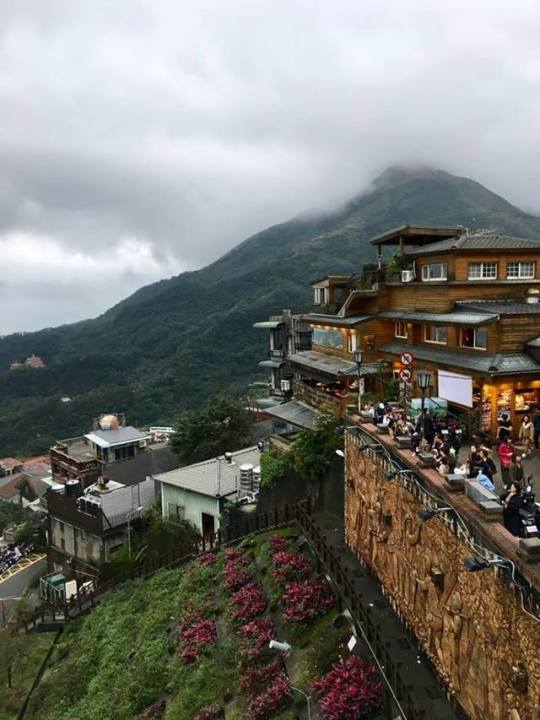
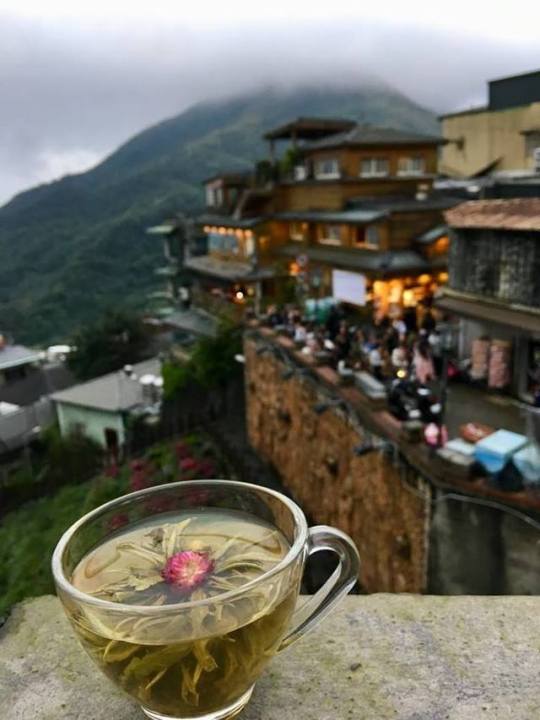
Amazing Taiwan
by Julia McCoy
I touched down in Taipei at 8PM, a little worse for wear from a nearly 14-hour flight. In my travels thus far, both for school and for fun, I had yet to visit Asia, and the first two hours did nothing to impress me. It was dark, it was rainy, and I was thoroughly car sick by the time I arrived at the hostel where we were to spend the next week-and-a-half. Maybe it’s just another city, I thought, as the front desk assistant explained the nuances of key cards, maybe it’ll just be another class location. It wasn’t until I arrived at my room on the fifteenth floor and opened my curtains that I understood: the view was spectacular. People can identify major cities worldwide from night photographs of their skyline, and though my view was from inside the city itself, it may well have been a postcard photo for the impression it made upon me. A lazy river, elegant suspension bridge, and a steady stream of tail and headlights on the right, an industrial district with only a smattering of lights like fireflies, and, in the far distance, a Ferris wheel. No two nighttime cityscapes are the same, and I fell asleep excited to see the city in the daylight.
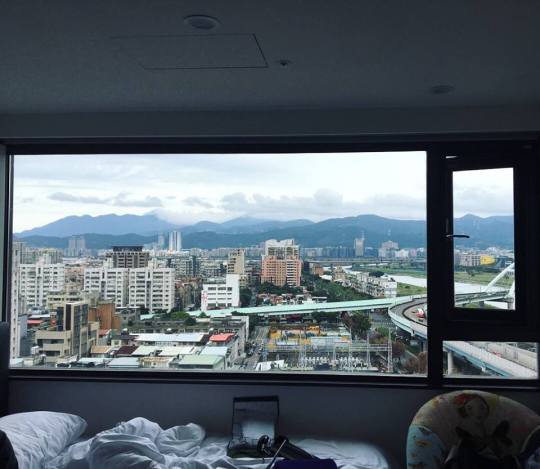
Three days later, with everyone settled in, Taipei begins to feel like an education, rather than vacation. New faces come together as students from two different LIU Global Centers, plus a few stragglers, meet and begin to compare notes. Have you had this professor before? Where did you spend your Winter break? Do you speak enough Mandarin to order me a bubble tea? What’s the best subway system you’ve been on? That last question is popular; in my personal opinion, Taipei is currently tied with Berlin, since they are equally spotless. We are all thrilled for the two classes we will be beginning here: Ethnic Minorities in China, taught by Professor Liu Wei, and Topics in Chinese Society and Change, taught by Dale Albanese. Most of our daily events are focused on Dale’s class, though we receive lectures in both. I find myself waking early again, a change from my habit at home, simply because I am so thrilled to begin my day. I also rise early to catch the free breakfast, complete with fresh juice. That’s something many students miss when they return to the States from the Global Centers, how much fresher the food tastes.

Though the food in Taipei is no exception, it is often the least exciting part of our busy days. Each day we are introduced to truly amazing people and visit impressive sites. One day we have lunch in the Legislative Yuan with KMT Legislator Jason Hsu, a charming man who tells us of his fight for marriage equality in Taiwan. The next afternoon, we are having a lively discussion on activism and politics with Brian Hioe, the editor of Taiwan’s independently published English-language magazine New Bloom. At night we are visiting the theater to view the subversive, emotional animated film On Happiness Road; later, I enjoy hot pot for the first time with my class as we compare how many times the movie made us cry. Left to our own devices, we wander through the exhilaratingly busy night market and eat every iteration of street food we can find. To my knowledge, no one had the courage to try the stinky tofu, though Dale promised us it tastes better than it smells. We rode the subway all the way out to the zoo and eschewed the animal attractions for the scenic gondola, riding it to the top of a lush mountain and rewarding ourselves with afternoon tea. Some nights, we stayed in and read, passing out at 9PM from sheer exhaustion. Every day was an adventure, but one, in particular, stands out.
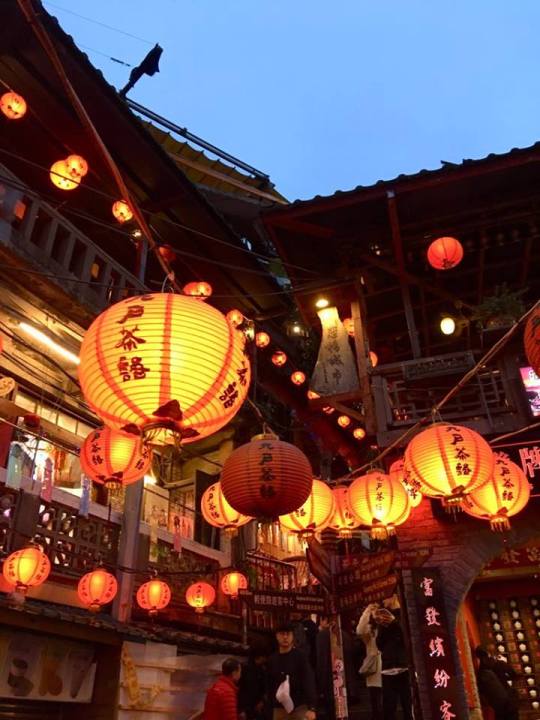
In preparation for writing this, I consulted with many of my classmates. I wanted to know their fondest memories, and their takeaways, and even their frustrations. I found that all anyone wanted to talk about was Yilan; if I’m being honest, it’s all I wanted to talk about either. So much happened that day, it took three of us to piece it together. Yilan is a county in Northeastern Taiwan. That morning, Dale woke us up at a rather unpleasant hour, herded us onto a bus, and acted as our hype man all the way to the Lanyang Museum. There, we were free to wander as we learned about the flora, fauna, tribes, history, and industry of the area. From the interactive displays to the lovely pier where we discussed our impressions and ate cherry tomatoes from a nearby stand, the hours flew by. Before we knew it, we were whisked away to a beautiful temple filled with rather intimidating carvings. Dale entreated us to dry a favorite local treat of his, a small crepe filled with vanilla ice cream, shaved peanut brittle, and cilantro for the brave. We meandered over a hill and down to the beach as we waited for dinner. I have found in my years here that, for many Global students, learning is most effective when punctuated by breaks in nature; as we tugged off our shoes and ran onto the beach, I thought I heard a collective sigh. I certainly heard one when it was time to leave, but dinner turned out to be well worth it. Now, when I think of a seafood restaurant in the U.S., I imagine that they have sides and alternatives to go with the main fare. This endless family-style meal had absolutely nothing but seafood, seafood, seafood. At this point, I was regretting my personal pledge at the start of the trip to try everything, but I am not a quitter. That night, I ate at least one bite of every dish on the table: fish intestines, whole squid, cuttlefish sausage, and so much more. As we all loosened our belts, I think we assumed there was no way to top the day we had just had.

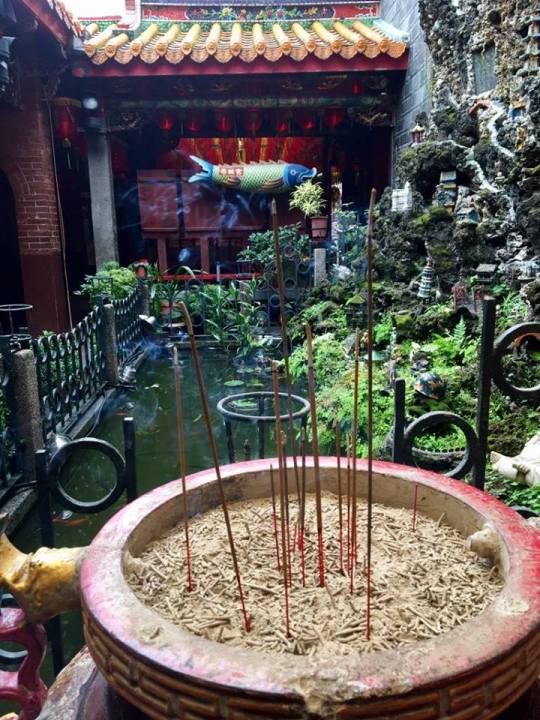
Every single person I asked said, unequivocally, that the after-dinner entertainment was the best part of the entire Taipei segment. It was the epitome of the Global experience, in that we learned more from this incredible experience, and generated more critical thought, than a three-hour lecture in a traditional classroom setting could ever replicate. That night, we attended a performance of the Paper Windmill Theatre. Founded in 1992, their many troupes travel the length of Taiwan, and sometimes further, bringing free theater to the children of small towns. They are funded by corporate donors and sponsorships and strive to bring artistic engagement to kids and their families who would otherwise not access is. The performance was engaging, innovative, and downright thrilling. Children from babies to preteens filled the audience with their parents; the director informed us later that 500 children were present that night, over half of the youth population in the entire town. They had acrobats, clowns, and a multilingual witch. There were funny skits, moral skits, and an entire five minutes of the audience throwing giant pool toy animals around. Though none of it was in English, I had only to look over my shoulder to see my classmates faces and know that they were enthralled. The grand finale involved the innovative use of pool noodles and a blacklight; incredibly low budget, but it will stick with me for the rest my life.
The reflection conversation the class had that night was Global College in its purest form. We spoke with passion, we asked a thousand questions, and each of us left with a burning desire to keep learning. It was all of these experiences that made our Taiwan trip distinct, an exhausting but perfect start to a semester in China. As the plane took off to ferry us to Hong Kong, I knew that, although we were all sad to go, those two weeks were only the beginning to our next Global adventure.
0 notes
Photo
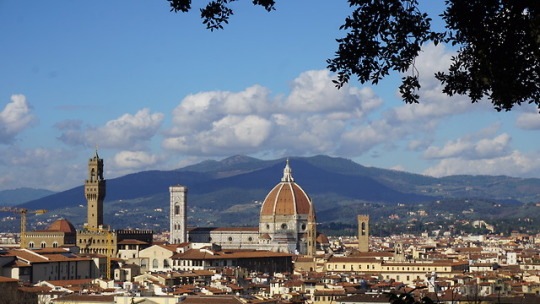
Studying in the city of Renassaince.
by Nora Gibbons.
After semesters in Costa Rica and Spain, the LIU Global class of 2020 all have
experience in the art of essay writing and crafting a written argument. But how many of us have had the chance to express our ideas in a visual or fine art form, through video or printmaking or drawing or photography? These are the opportunities we have had over the last couple of months at the Florence School of Fine Arts. Now, not only do we have the skills to write a research paper on our favorite global issue, we also have experience creating documentary videos about climate change or using augmented reality technology to comment on the visibility of women in a variety of realms.
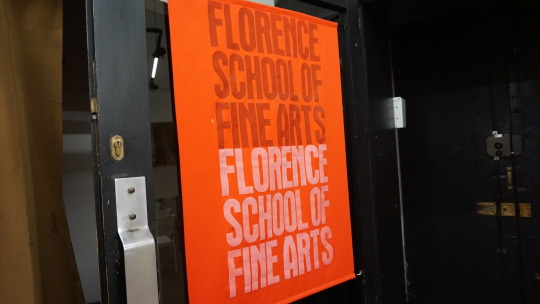
Located in the Santa Croce neighborhood in central Florence, the Florence School of Fine Arts, according to cofounder Melania Lanzini, “is an innovative arts program bringing forth new ideas and different approaches to teaching.” The school itself is actually located in the former home of Giorgio Vasari, a notable writer, architect, and artist in the Renaissance. And this is not the only brush with history that we get to experience throughout our days in Florence.

Some of us wake up to a view of frescos on our bedroom ceilings in our apartments or walk past Brunelleschi’s famous Duomo on our way to school. We spend each Friday morning some of the most renowned museums and historical sites in Florence, learning about Renaissance art from our professor Frederica, a talented art historian.
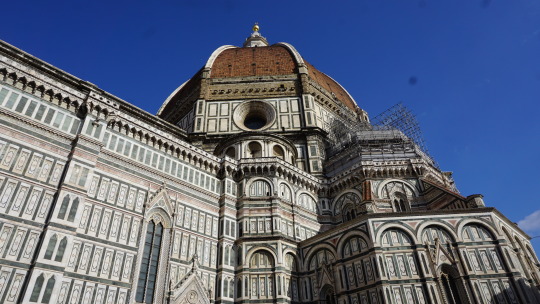
In addition to the Renaissance art class, the Florence School offers us courses in Italian language, interactive design, filmmaking, and world cinema. For those of us Global students able to take an overloaded schedule there are also opportunities for drawing, photography, printmaking, letterpress, and bookbinding classes.
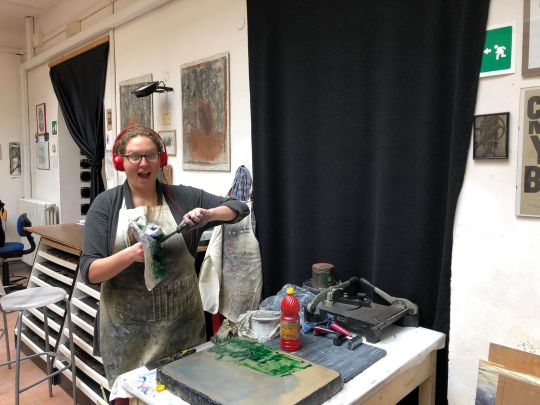
For many of us, our only wish is that we could have taken advantage of more of the courses offered at the Florence School.
Since we are each taking different electives based on our interests, each of our days looks different. Some of us may head to the studio early to work on interactive design projects, using technology on smartphones to turn photos, drawings, and paintings into an interactive sight and sound experience or to work on hand binding books of our artworks. Others may have a slower
morning in our apartments drinking a cappuccino and preparing for a world cinema presentation later in the day.

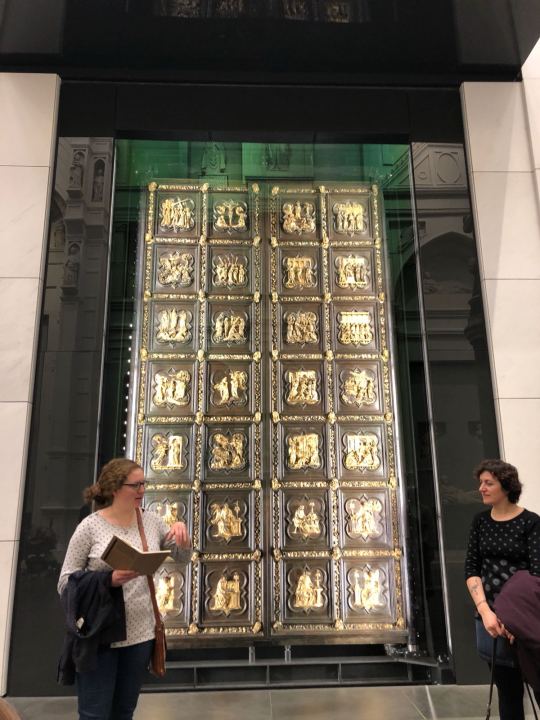
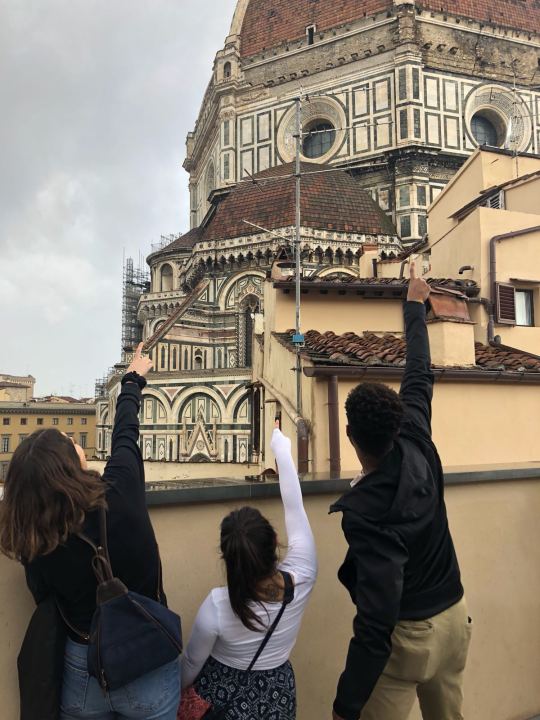
The main constant throughout our diverse days though is the opportunity to express ourselves creatively, surrounded by a city filled with inspiration.
For many of us though, the best part of this experience is the people.
We have been so grateful for the support of the Florence School founders, Charles Loverme and Melania Lanzini, and all the staff of the Florence School. From advice and guidance on our creative projects to fixing a
leaking washing machine late at night, we can always count on them to support us and advocate for us and cannot thank them enough.
#florence#italy#italia#firenze#renascimento#renaissance art#renaissance#liu global#nora gibbons#art#art school#college#college abroad#santa croce
2 notes
·
View notes
Text
Schol in Vienna by Nora Gibbons
The LIU Global Europe Center students started off their semester with a chilly and busy trip to Vienna and Budapest. The experiential learning excursions we participated in there mostly focused on visits to intergovernmental organizations, like OPEC and the UN offices. Our last day’s visit was quite different though, and for some students, quite impactful. The group visited a primary school in Vienna. We began with listening to a presentation about the school system in Austria in general, as well as some of the specific practices of this school.
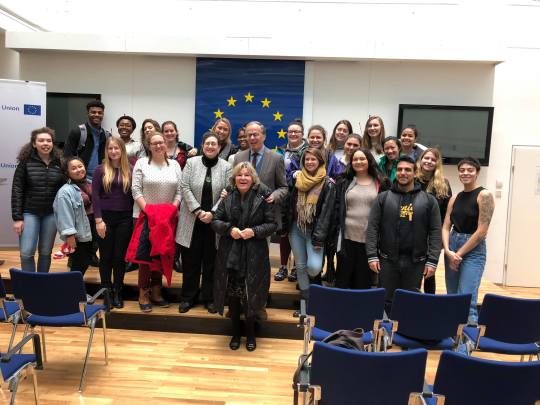
One of the most interesting things for many Global students was the system of age mixed classrooms. Mixed age learning environments are not the norm in most public schools in the US, although they do exist in many alternative learning environments. Psychologist Peter Gray at Boston College has conducted numerous studies on the benefits of this type of learning environments. He summarizes some of his findings in a 2011 article in the American Journal of Play entitled “The Special Value of Children’s Age Mixed Play” as such: “age-mixed play offers advantages for learning skills, culturally relevant information, cultural routines, nurturance, and leadership that go beyond those of same-age play.”
Our class at Global comes from a diverse educational background, so we had many different viewpoints on the concept of mixed age classrooms before this experience. Some of us did were International Baccalaureate students, some took AP classes, some came from Waldorf and Montessori schools, some are self-directed learning and democratic free school enthusiasts. Some of us fall into none of those categories, some a combination of a few. However, after learning a bit about the implementation of this mixed age system we were able to put our previous perceptions aside as best we could, and head into classrooms to observe this in action. We split up and visited classrooms in groups of two or three. Because the teachers in these classrooms have a wide range of freedom in lesson planning, each group of Global students observed very different environments and activities. Although some Global students did not feel that the classrooms they observed were effective learning environments, one Global group, in particular, participated in a very powerful experience. Gwen Lindberg, Seeley Davidson, and Aaleah Oliver observed a mixed age consent workshop of sorts. Below is an interview with them about this experience.

What thoughts or impressions did you have of mixed age learning environments before visiting this school?
SD: I was in Montessori school growing up so I was in mixed-age classrooms until 5th grade. I have mixed opinions but for the most part, it's positive.
GL: I personally think age shouldn’t be the defining factor in class placement. It should be based on each student’s individual preferences, learning style, areas of interest (or particular talent), that sort of thing. If students are placed into classes based on those criteria, that automatically creates mixed-aged learning environments that are more catered towards kids’ needs and desires.
AO: Before visiting this school, I thought that mixed aged learning environments were what happens when a school is underfunded and forced to group students of different ages together in order to save money.
How did you find the overall vibe of the classroom to be?
SD: The room I was in seemed super loving and based on the mutual happiness of all students! It all seemed positive and productive and as though everyone in the space was getting as much as they personally could out of the experience.
GL: I thought this mixed-age class was a really good example of an excellent classroom environment. Students of different ages and backgrounds intermingled with no discernible separation or ostracism (granted this is based on a very brief period of time, so my observations need a lot more evidence). I was particularly impressed with the way some students helped to translate instructions, assignments, or announcements for each other; language barriers did not a pose a problem, as students worked together or just about everything.
AO: The vibe of the classroom was relaxed and focused. Most, if not all, of the students, appeared to be engaged in the workshop
Can you describe the activity or conversation you observed in the classroom?
SD: The activity we walked in on was consent training performed by an outside organization. As soon as we entered the room one of the adults asked the students if they felt comfortable having visitors in the room. One student had been in the bathroom during this process and when he returned he was asked individually. There were three session leaders and three teachers. It was all conducted in German and since none of us speak the language we were pretty lost, but after watching for a bit we were able to infer it was a consent training session. The three organizational staff members were engaging everyone in a conversation about 'good touch' and 'bad touch'. These leaders were acting out a skit about different kinds of touch with various people in their lives. Afterwards was a session where students worked together to identify touches on a worksheet including where they filled in their own answers and made their own scenarios. A high point of this experience was a conversation I had with a teacher about the students in the class and why she thought this kind of education was important. She was super excited to chat about her views, and also reminded me of the personal experiences each student came into that environment with, specifically refugee students, and why this type of workshop is helpful for them. She also talked about her own experience growing up as a first-generation immigrant in Austria and how she uses her story to relate to the children she teaches.
AO: I observed a consent training workshop that appeared to be broken up into section: the facilitators of the workshop would perform a few short skits, then the facilitators asked the students some questions, (that appeared to require some reflection from the students), then the classroom of students separated and began individual work on a handout where different body parts went down the page vertically and feelings were written horizontally. I believe the students had to decide which people made them feel that when they touched them somewhere.
How do you think this activity may help or inform the students now and later in life?
SD: Consent training is important from day one. It should be a required course when kids start school and transition into consent plus sex ed when the time comes. I feel like people have a lot of misconceptions about what consent training looks like, and it wasn’t at all a weird environment where kids were expected to act as formal mini-adults, they were still their goofy ridiculous selves but with a new knowledge that they hadn’t had before that they could now reference in play. These lessons are important because they give people a language for feelings that are difficult to explain or express. Now when they wrestle and play there will be a context for them (and their teachers) to refer back to when these issues of consent come up.
AO: I think this activity will help the students to be aware of and respect their physical boundaries and the physical boundaries of others
Did you have any previous experience with consent training? How did this experience impact you?
SD: Yes, I'm kind of obsessed. I've been looking for a comprehensive consent training course that I feel like is easily translated to different languages and relatable to people of many different cultures for a while now! I don’t think what I witnessed in Vienna was the full answer, but it was incredible to witness firsthand and to get insight into the methods of people trying to accomplish similar goals.
GL: I have never been a part of consent training before, but this seems like an absolutely incredible way of teaching young kinds to be open and comfortable. It acts as both an indicator of possible abuse, and as a way for kids to very concretely lay out how they feel about certain people and certain touch, with no external peer or societal pressure. I sincerely wish this could have been something I participated in as a kid, and I want to help spread this idea to a grand scale.
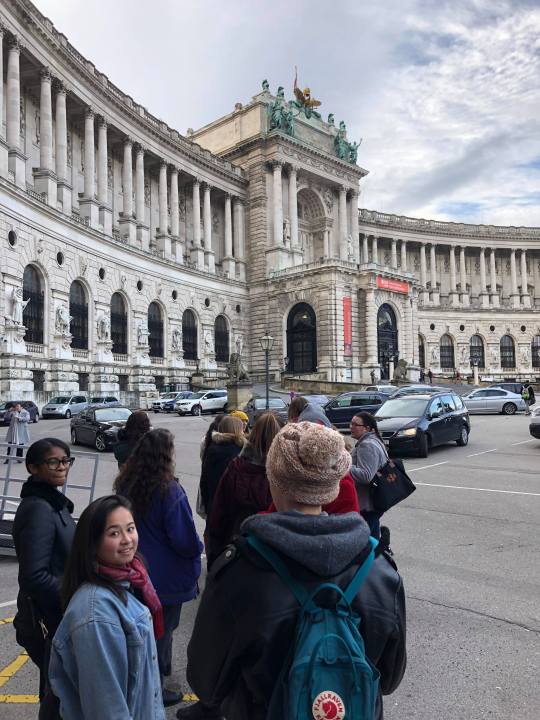
3 notes
·
View notes
